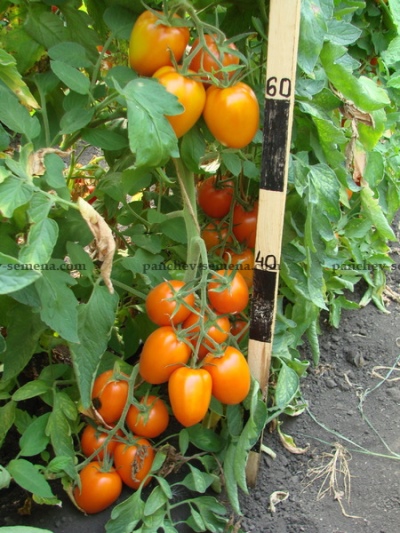
- Authors: Yuri I. Panchev
- Year of approval: 2010
- Category: hybrid
- Growth type: indeterminate
- Appointment: fresh consumption, for pickling and preserving
- Ripening period: mid-early
- Ripening time, days: 102-107
- Growing conditions: for open ground, for film greenhouses
- Bush height, cm: 180-210
- Foliage: medium
Experienced summer residents and gardeners try to grow not only classic types of tomatoes, but also varieties that decorate the beds and plots. One of these is a mid-early tomato with an attractive appearance of Stesha fruits.
Breeding history
This mid-early variety Stesha was created by a breeder from the Transnistrian Republic - Panchev Y. I. in 2008. The nightshade crop was added to the ranks of the nightshade crop allowed for use in the Russian Federation in 2010. The hybrid can be grown both in beds and in greenhouses. The view is zoned for all climatic zones of the country.
Description of the variety
Hybrid tomato Stesha is a tall plant of an indeterminate type. Vigorous bushes grow up to 180-210 cm and are characterized by medium foliage with rich green leaves, moderate branching, developed root system and intermediate inflorescences. The first fruit cluster appears above the 7-9 leaves, where 5-6 berries are tied. Ovaries are formed very well.
When growing, the plant requires the formation of a bush of 1-2 stems, the timely removal of stepsons and a garter to the supports with synthetic material. According to experienced gardeners, it is better to tie the bushes to trellises, since a simple peg may not be enough.
Tomato belongs to universal varieties, so it is eaten fresh, canned, pickled and processed into sauces.
The main qualities of the fruit
Tomatoes with an attractive appearance are medium-sized. The average weight of the berries is 150 grams. They are characterized by an obovate shape with a perfectly smooth surface. The color of the vegetable is beautiful and unusual - intense orange or amber yellow in ripe form, and green with a light speck at the base - in an unripe form. The skin of the vegetable is quite dense, but not tough. Tomatoes are resistant to cracking, but do not tolerate transportation very well, in addition, vegetables are stored only if the conditions are met.
Taste characteristics
Despite their hybridity, tomatoes are famous for their excellent taste. The flesh of the vegetable is dense, fleshy, juicy enough, but not watery. There are practically no seeds in the pulp. The taste is dominated by pronounced sweetness without the slightest acidity, complemented by a dessert aroma. Due to its unique composition, Stesha tomato is included in baby and diet food.
Ripening and fruiting
Stesha is a mid-early tomato. From germination of seedlings to the formation of ripe berries on the bushes, 102-107 days pass. Tomatoes spice up together. The peak of fruiting occurs at the end of July and August.
Yield
The yield indicators of the variety are good. Taking care of the crop, the gardener will certainly get a good and tasty harvest. On average, 3.7 kg of tomatoes per 1 m2.
The timing of planting seedlings and planting in the ground
Tomato is grown exclusively through seedlings. Sowing seeds is carried out in late March - early April. It is possible to deepen the seeds into the ground by 1.5-2 cm. For the rapid germination of sprouts, a greenhouse effect is provided by means of glass or film. At the stage of appearance of 2-3 leaves, the bushes should be planted in separate pots. A week before transplanting, plants need to be hardened by exposing them to fresh air for 20-30 minutes, which ensures their quick adaptation to new growth conditions.
The bushes can be transferred at the age of 55-65 days, when the air is warm enough, and there is also no threat of nighttime cold snaps. Planting is carried out from mid-May to the first ten days of June - earlier in the greenhouse, and later in the garden.

Growing tomato seedlings is an extremely important process, because it largely depends on whether the gardener can harvest at all. All aspects must be taken into account, from seedbed preparation to planting in the ground.
Landing scheme
It is important to observe not only agricultural techniques, but also the scheme and density of planting of tomato bushes. 4 bushes are allowed per 1 m2. The optimal layout for planting is 70x30-40 cm.

Growing and caring
The tomato is picky about the ground. It needs a fertile, breathable, lightweight, moisture-absorbing soil that is well illuminated by the sun. The best for growing will be the area where cabbage, carrots, legumes or onions were previously grown.
Comprehensive care includes frequent watering with warm water, the introduction of mineral and organic fertilizers, especially during the growing season, weeding and loosening of the soil to get rid of weeds, the formation and tying of bushes, regular removal of stepchildren, pinching the tops, as well as protection from viruses, fungus and insects ... When growing tomatoes in a greenhouse, it is recommended to ventilate to prevent excess moisture and dampness.




A plant needs different micronutrients at each stage of growth. All fertilizers can be divided into two groups: mineral and organic. Folk remedies are often used: iodine, yeast, bird droppings, eggshells.
It is important to observe the rate and period of feeding. This also applies to folk remedies and organic fertilizers.
Disease and pest resistance
The variety has a high genetic resistance to many nightshade diseases - Alternaria, tobacco mosaic virus, late blight. Preventive spraying with biological products will protect against invasions of aphids, spider mites and Colorado potato beetles.


Resistant to adverse weather conditions
The plant tolerates many weather disasters - short droughts, temperature fluctuations, slight cold snaps and heat. The culture does not tolerate only drafts and prolonged shade.

























































































